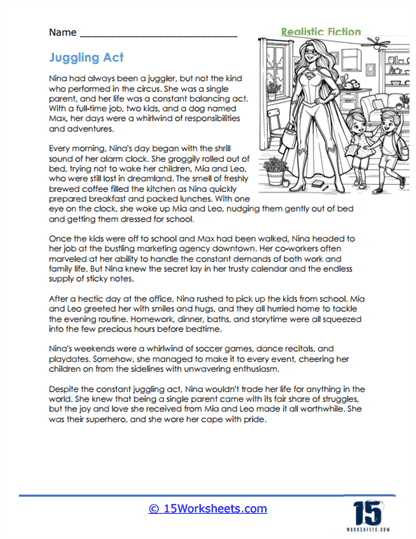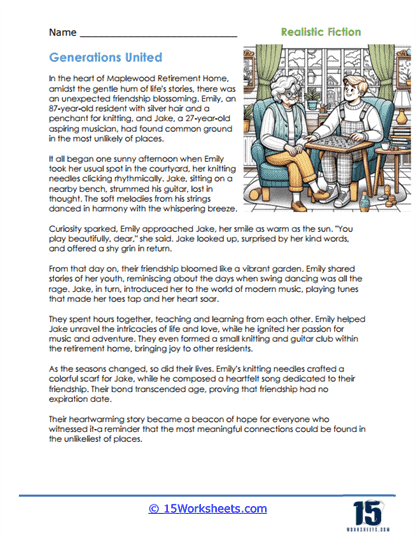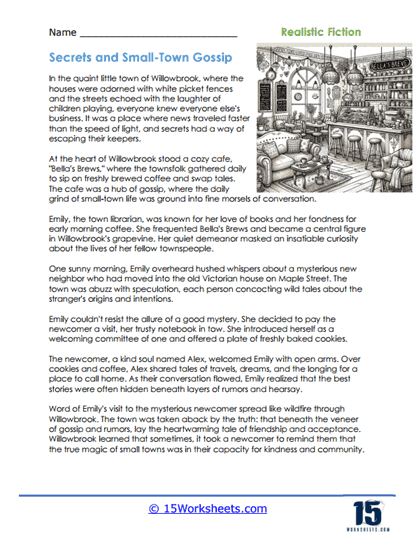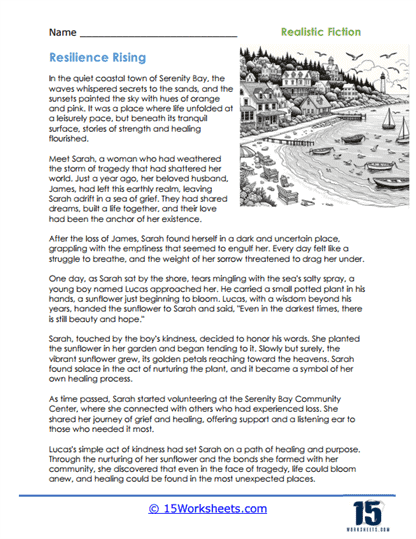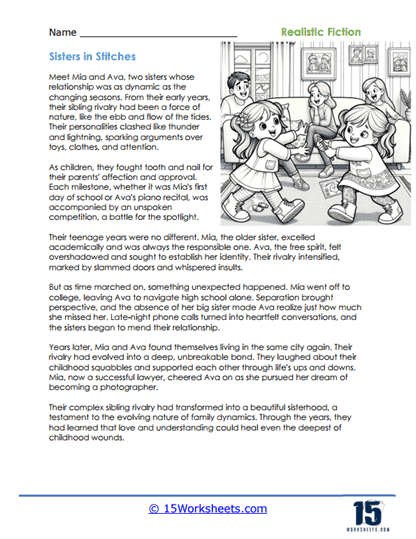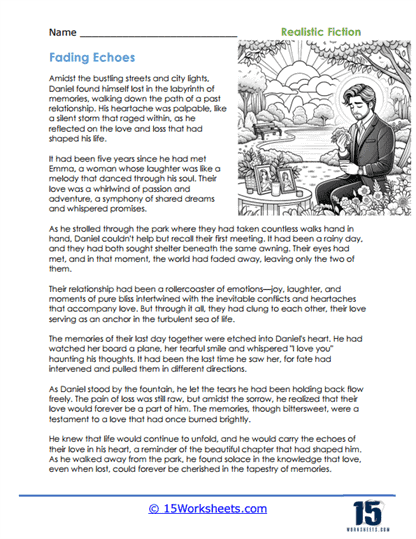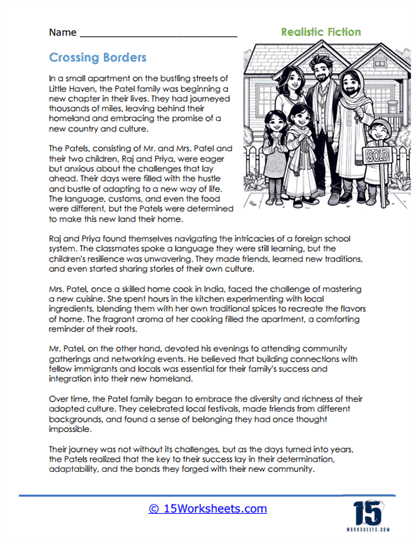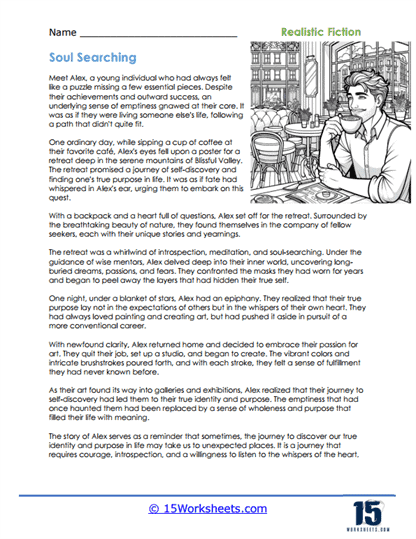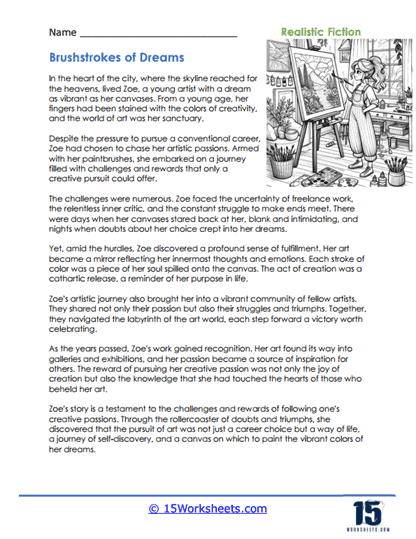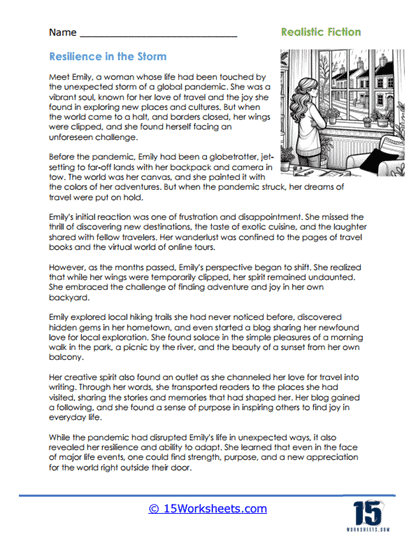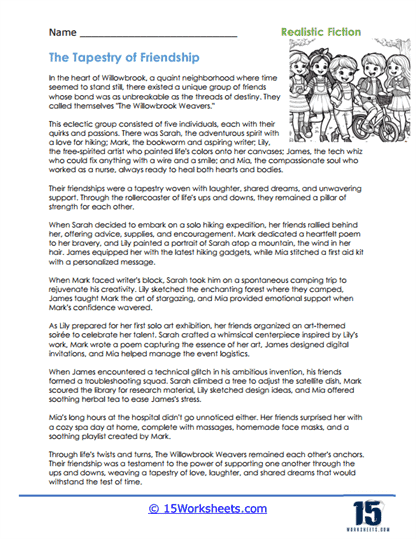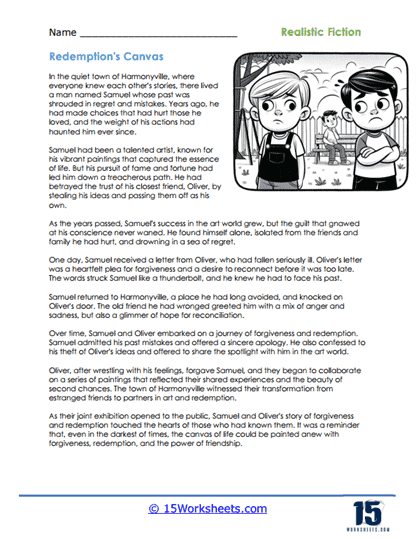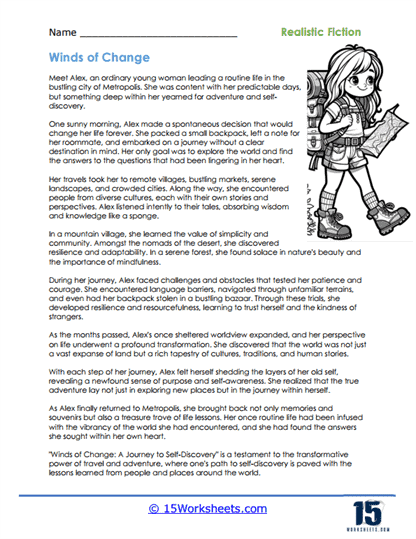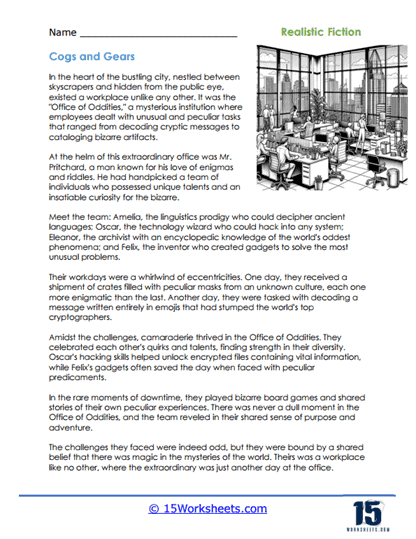Realistic Fiction Worksheets
About These 15 Worksheets
Realistic Fiction Worksheets are educational tools designed to enhance students’ understanding and appreciation of the realistic fiction genre. These worksheets contain a variety of exercises tailored to help students engage with, analyze, and understand stories that depict real-life situations in a fictional context. Realistic fiction, as a genre, presents narratives that could feasibly occur in the real world, featuring characters, settings, and plots that are relatable and believable.
Types of Exercises
Comprehension Questions – These are fundamental to realistic fiction worksheets. They require students to recall and interpret information from the text. Questions may range from basic (‘What did the main character do in response to…?’) to more complex (‘Why do you think the character reacted in this way?’).
Character Analysis – This exercise involves examining the characteristics, motivations, and development of characters within the story. Students might be asked to describe a character’s personality, identify their strengths and weaknesses, or analyze how they change throughout the story.
Setting Analysis – Here, students focus on the time and place in which the story is set. They may explore how the setting influences the plot or characters and might be asked to describe how the setting contributes to the story’s realism.
Plot Analysis – This exercise helps students understand the sequence of events in the story. They might create timelines, identify the main conflict, or discuss the resolution of the plot.
Theme Identification – Students are asked to determine the central themes or messages of the story. This might involve discussing how the story’s events and characters convey certain ideas about life or society.
Vocabulary Development – Realistic fiction worksheets often include activities focused on the language used in the text. This could involve finding and defining unfamiliar words, using context clues, or exploring language and idioms specific to the setting of the story.
Predictive Analysis – These exercises encourage students to make predictions about future events in the story based on their understanding of the characters and plot.
Comparative Analysis – Students may compare and contrast elements within the story, such as different characters’ reactions to the same event, or they might compare the realistic fiction story to real-world events or their own experiences.
Creative Writing Prompts – These prompts encourage students to write their own realistic fiction stories or to rewrite parts of the story from a different character’s perspective.
Discussion and Reflection Questions – These are open-ended questions designed to promote critical thinking and personal connection to the story. Students might reflect on how the story relates to their own life or discuss moral and ethical questions raised by the narrative.
What is the Realistic Fiction Genre of Writing?
Realistic Fiction is a genre of writing that creates narratives set in a world that closely mirrors the real one. These stories focus on believable characters, settings, and events that could feasibly happen in real life. Unlike fantasy or science fiction, realistic fiction does not involve supernatural elements or futuristic scenarios. Instead, it often explores everyday experiences, personal relationships, social issues, and emotional journeys, making the stories relatable to readers.
Characteristics of Realistic Fiction
Believable Characters – Characters in realistic fiction are typically complex, multifaceted, and undergo character development throughout the story.
Real-world Settings – The settings are recognizable and familiar to readers, such as contemporary cities, towns, or rural areas.
Plausible Plotlines – The events and conflicts in these stories are ones that could occur in real life, such as family dynamics, personal struggles, or societal issues.
Contemporary Issues – Realistic fiction often addresses current social, emotional, or moral dilemmas.
Emotional Depth – These stories tend to delve deeply into the emotional and psychological experiences of the characters.
Examples in Literature
“To Kill a Mockingbird” by Harper Lee – This classic novel is set in the American South and deals with serious themes such as racial injustice and moral growth, as seen through the eyes of a young girl.
“The Catcher in the Rye” by J.D. Salinger – Focused on the experiences of Holden Caulfield, this novel explores themes of teenage angst and alienation in a post-war America.
“The Great Gatsby” by F. Scott Fitzgerald – Set in the Roaring Twenties, this novel offers a critical look at the American Dream through the lives of its complex characters.
“The Fault in Our Stars” by John Green – A contemporary novel that explores love, tragedy, and existential questions through the lives of teenagers dealing with cancer.
“Pride and Prejudice” by Jane Austen – While set in the early 19th century, this novel is a timeless exploration of manners, upbringing, morality, and marriage in British society.
“A Thousand Splendid Suns” by Khaled Hosseini – Set in Afghanistan, this novel tells the story of two women and their life experiences under various regimes.
“Americanah” by Chimamanda Ngozi Adichie – A modern novel that explores themes of identity, race, and the immigrant experience, focusing on a young Nigerian woman who immigrates to the United States.
“Little Fires Everywhere” by Celeste Ng – This contemporary novel delves into family dynamics, motherhood, and the complexities of the suburban experience.
The Benefits of These Worksheets
The worksheets play a crucial role in enhancing reading comprehension through various means. One of the primary benefits is the improvement of critical thinking skills. When students analyze characters, settings, and plots, they are prompted to think critically about the story’s components. This process not only enables them to comprehend what transpires in the narrative but also delves into the reasons behind these events, ultimately leading to a more profound understanding.
These worksheets aid in building empathy and understanding. Realistic fiction often delves into relatable situations and emotions. Students, through engaging with these worksheets, can immerse themselves in the shoes of the characters, fostering empathy and gaining a better understanding of diverse experiences and perspectives. Another significant advantage is the enhancement of vocabulary and language skills. Vocabulary exercises embedded within these worksheets allow students to refine their language capabilities, rendering them more proficient at deciphering and interpreting intricate texts.
Developing predictive skills is another vital aspect. By making predictions, students learn to utilize context clues and their prior knowledge to anticipate what might transpire next in the story. This skill proves invaluable for grasping narrative structure and identifying foreshadowing elements in literature.
Moreover, these worksheets encourage active engagement with the text. Their diverse range of exercises ensures that students engage with the material on multiple levels-intellectually, emotionally, and creatively. This comprehensive engagement contributes significantly to the solidification of their understanding and recall of the content. These worksheets foster the development of analytical writing skills. Many exercises prompt students to provide written responses, helping them refine their ability to express their thoughts and analysis in writing-a critical skill for academic success.
They promote discussions and the exploration of diverse perspectives. Discussion questions included in these worksheets encourage students to express their viewpoints and listen to others’ interpretations. This exchange of ideas can broaden their understanding and appreciation of the text, further enriching their reading experience.

